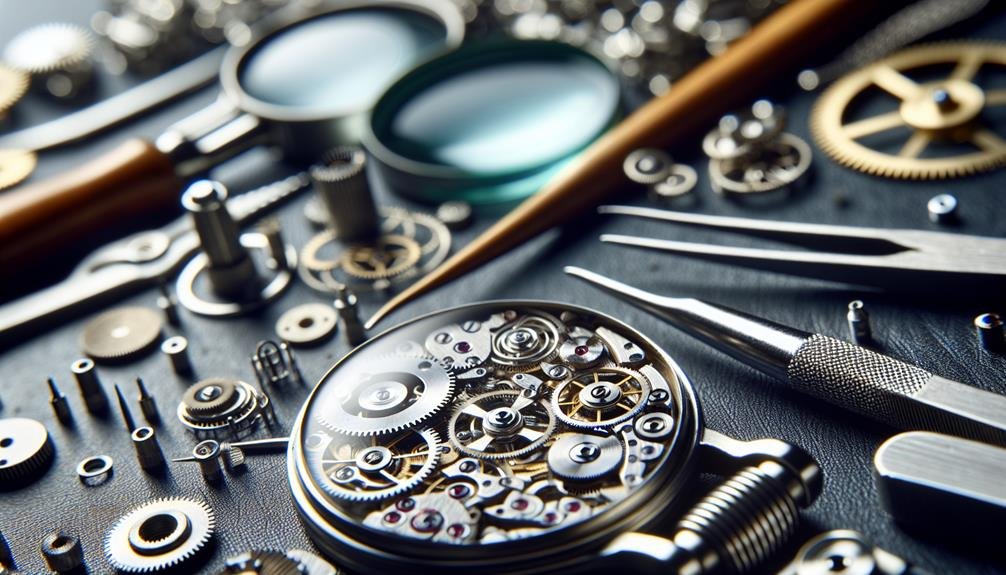Watch movements, or calibers, are the soul of your timepiece. Mechanical movements, rooted in 16th century engineering, use tightly wound springs and offer intricate artistry. They don't need batteries. Quartz movements, powered by a quartz crystal and battery, offer modern precision. You'll only lose a few seconds a month. Then, there's the hybrid mecha-quartz, combining the best of both worlds. Luxury watch brands showcase these masterpieces, mixing craft, art, history, and engineering. Mastering movements goes beyond timekeeping, it's exploring the craftsmanship that ticks inside your watch. Dive in, there's much more to unravel.
Understanding Watch Movements

Diving into the world of watches, you'll find that understanding watch movements, the heart and soul of timepieces, is crucial to appreciating their craftsmanship and functionality. These movements, also known as calibers, are the intricate internal mechanisms that power the watch and keep time.
To understand these marvels of engineering, let's take a quick Movement History Overview. The earliest watches, dating back to the 16th century, used mechanical movements. These pieces relied on winding to store energy in a mainspring. This energy was then gradually released to power the watch.
Fast forward to the 20th century, and you'll see the advent of automatic or self-winding movements. These sophisticated mechanisms harness the power of your wrist's movement to wind the mainspring.
Now let's move to Movement Types Comparison. The two main types are mechanical movements, which we've discussed, and quartz movements, which we'll delve into later. While mechanical movements are revered for their craftsmanship, they're not as accurate as their quartz counterparts.
In short, understanding watch movements isn't just about knowing what makes your watch tick. It's about appreciating the history, engineering, and craftsmanship that go into every timepiece.
Quartz Movements: A Primer
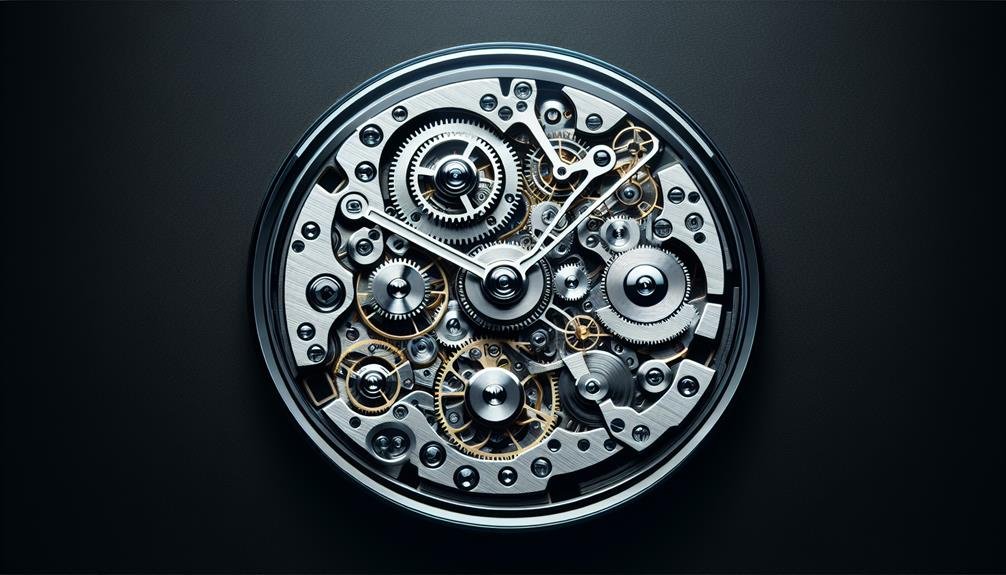
Now, let's turn our attention to quartz movements, a modern and highly accurate alternative to traditional mechanical movements. Quartz movements set the standard for accuracy in the world of watches. This is due to the oscillation of a quartz crystal inside the watch, powered by a battery, that keeps incredibly precise time. It's the quartz accuracy that's the real game-changer here.
Quartz watches lose only about a few seconds per month, which is far superior to mechanical watches. This accuracy is one of the main reasons why quartz watches have become so popular since their introduction in the 1960s.
However, the battery lifespan is also a significant factor to consider. A standard quartz watch battery lasts about two years. But don't worry, replacing the battery is a quick and inexpensive process. This means that with a quartz watch, you won't have to worry about consistent maintenance like you'd with a mechanical watch.
The Intricacies of Mechanical Movements
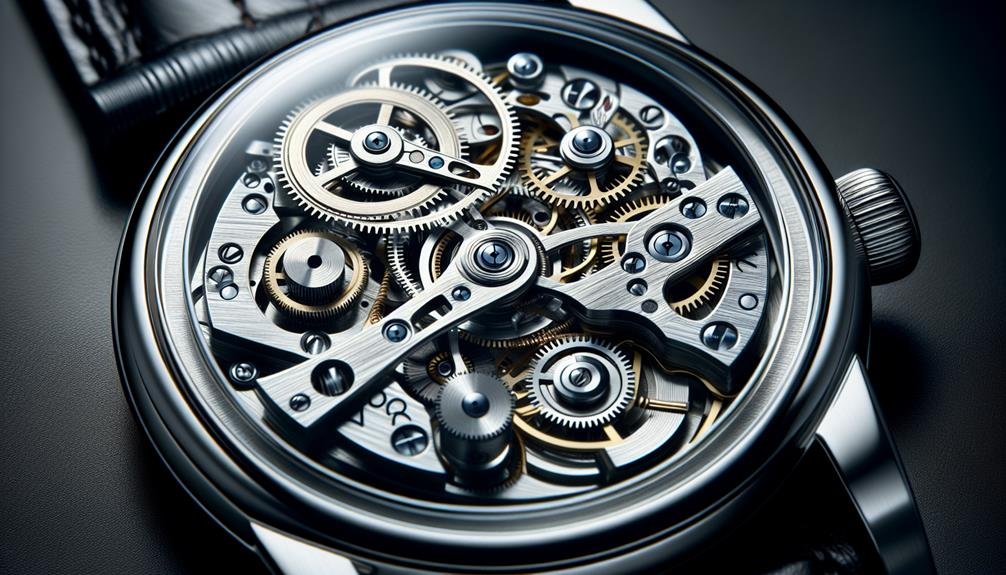
While quartz movements boast impressive accuracy, let's explore the complex world of mechanical movements, known for their intricate craftsmanship and timeless appeal. These movements are a marvel of engineering, where every tiny part has a role in ensuring movement precision. Unlike quartz, mechanical movements don't require batteries. Instead, they're powered by a tightly wound spring.
Now, let's delve deeper into movement complications, another fascinating aspect of mechanical watches. Complications refer to any function on a watch beyond mere timekeeping. These may include features like a date display, stopwatch, or moon phase indicator. They're called complications because they complicate the watchmaking process. Each additional function requires more parts, more precision, and more craftsmanship.
Mechanical movements aren't just timekeepers; they're works of art. The intricate assembly of gears, springs, and levers is a sight to behold, especially through a transparent case back. They mightn't match quartz movements in accuracy, but the charm of a meticulously crafted mechanical movement is undeniable. It's like owning a piece of horological history on your wrist. So, when you choose a mechanical watch, you're not just buying time; you're investing in a masterclass of watchmaking tradition.
The Hybrid: Mecha-Quartz Movements

Blurring the lines between tradition and modernity, mecha-quartz movements offer you the best of both worlds: the intricate craftsmanship of mechanical watches and the precision of quartz timekeeping. This hybrid movement evolution combines a mechanical chronograph with a quartz base, allowing for the charm of a sweeping second hand typically seen in mechanical pieces while maintaining the accurate timekeeping of quartz watches.
One of the main Mecha Quartz advantages is its power reserve. You'll appreciate not needing to wind your watch daily as quartz movements are battery-powered. In addition, the hybrid nature of these movements provides a smooth sweep of the second hand, giving a nod to traditional mechanical movements, without the hefty price tag often associated with them.
Furthermore, Mecha-Quartz watches are generally more durable and require less maintenance than their fully mechanical counterparts. This makes them a smart choice if you're looking for a watch that combines the allure of mechanical movements with the practicality of quartz.
Luxury Brands and Their Movements
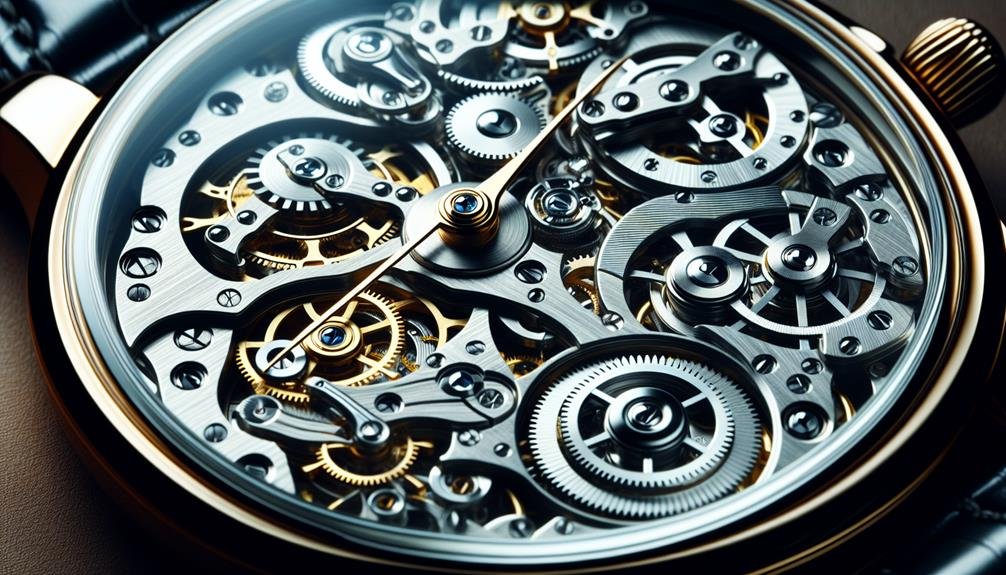
Diving into the realm of luxury brands, it's essential to understand the unique watch movements they employ to set themselves apart. Iconic Movements in Luxury Watches are like the heartbeat of these stunning timepieces. Brands such as Patek Philippe, Audemars Piguet, and Rolex have movements that aren't just about telling time, they're about showcasing craftsmanship and innovation.
The Evolution of Brands' Movements is a fascinating journey. With each passing year, these luxury brands push the boundaries of what's possible in watch design. They've moved from basic mechanical movements to intricate designs that can include moon phase indicators, tourbillons, and perpetual calendars.
You'd find that brands like Jaeger-LeCoultre have even patented their movements, while others like Vacheron Constantin have maintained a tradition of manual winding.
Understanding these movements can deepen your appreciation for your timepiece. It's not just a watch; it's a statement of personal style and a testament to human ingenuity. So, when you strap on that luxury watch, you're not just wearing a brand. You're wearing a piece of art, a piece of history, and a marvel of engineering.
Watch Movement Maintenance Tips
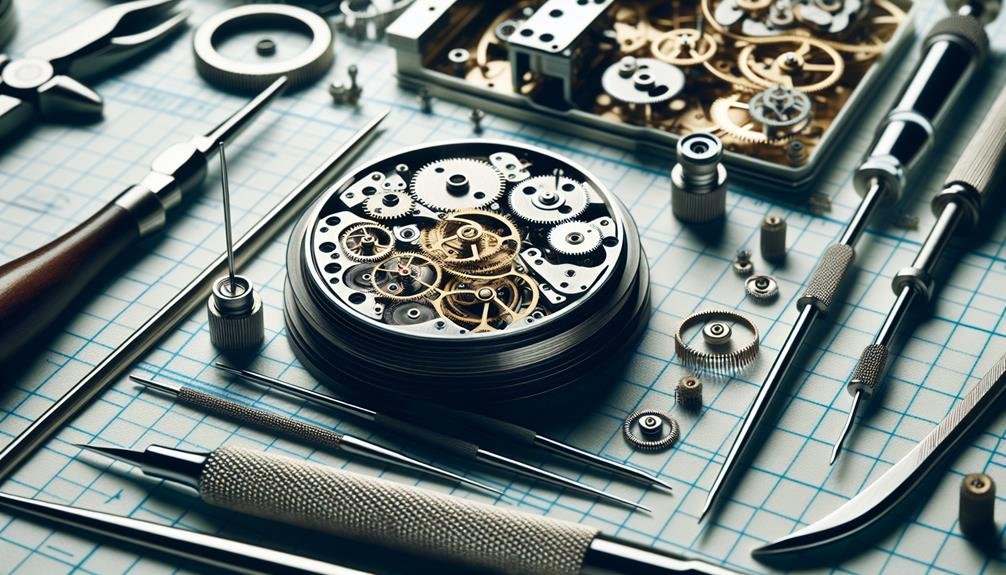
Properly maintaining your watch movement isn't just about preserving its functionality; it's about honoring the craftsmanship and engineering that went into its creation. You've got to treat it like the precision instrument it is.
First, let's talk about cleaning techniques. Your watch is a work of art, but dust and grime can easily creep into the movement. A watchmaker's cleaning machine is best for a thorough cleanse, but you can use compressed air to blow away surface dust. Avoid using water or harsh chemicals, as they can cause irreversible damage.
Next, consider movement upgrades. Over time, movements can wear or become outdated. Upgrading to a better or more modern movement not only enhances your watch's performance but also increases its lifespan. Don't forget to consult a professional watchmaker to ensure the upgrade fits your watch style.
Conclusion
So, you've journeyed through the world of watch movements, from quartz to mechanical, even touching on mecha-quartz hybrids.
You've peeked into luxury brands and their bespoke movements.
Now, it's time to apply your newfound knowledge. Remember, proper maintenance is key to keeping your timepiece ticking smoothly.
With this guide, you're now equipped to appreciate the intricate dance of gears and springs that make your watch more than just a time-telling device.
